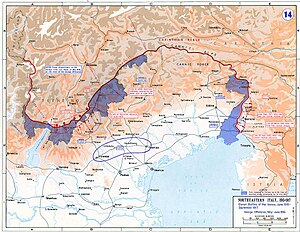
Back Першая бітва пры Ізонцы Byelorussian Първа битка при Изонцо Bulgarian Erste Isonzoschlacht German Primera batalla del Isonzo Spanish Première bataille de l'Isonzo French הקרב הראשון על האיזונצו HE Első isonzói csata Hungarian Pertempuran Isonzo Pertama ID Prima battaglia dell'Isonzo Italian 第一次イゾンツォの戦い Japanese
This article includes a list of general references, but it lacks sufficient corresponding inline citations. (February 2013) |
| First Battle of the Isonzo | |||||||
|---|---|---|---|---|---|---|---|
| Part of the Italian Front (World War I) | |||||||
 Eleven Battles of the Isonzo June 1915 — September 1917 | |||||||
| |||||||
| Belligerents | |||||||
|
|
| ||||||
| Commanders and leaders | |||||||
|
|
| ||||||
| Strength | |||||||
|
225,000: (18 divisions 252 battalions 111 cavalry squadrons 700 guns) |
115,000: (8 divisions 84 battalions 13 cavalry squadrons 356 guns) | ||||||
| Casualties and losses | |||||||
| 15,000[1] | 10,000[1] | ||||||
The First Battle of the Isonzo was fought between the armies of Italy and Austria-Hungary on the northeastern Italian Front in World War I, between 23 June and 7 July 1915.
The aim of the Italian Army was to drive the Austrians away from its defensive positions along the Isonzo ( Soča) river and on the nearby mountains and hopefully capture the port of Trieste.
Although the Italians enjoyed a 2:1 numeric superiority, their offensive failed because the Italian commander, Luigi Cadorna, employed frontal assaults after impressive (but short) artillery barrages. The Austro-Hungarians had the advantage of fighting from uphill positions barricaded with barbed wire which were able to easily resist the Italian assault.
The Italians had some early successes. They partially took Monte Nero (Monte Krn), took Monte Colowrat, and captured the heights around Plezzo. However, they were unable to dislodge the Austro-Hungarian troops from the high ground between Tolmino and the Isonzo, which would later form a launching off point for the Caporetto Offensive. The heaviest fighting occurred around Gorizia. In addition to the natural defenses of the river and mountains, bastions were created at Oslavia and Podgora. The fighting at Gorizia consisted of street-by-street urban combat interspersed with artillery fire. Italian troops, such as the Italian Re and Casale Brigades, were able to advance as far as the suburbs but could get no further and were driven back. They made small footholds at Sagrado and Redipuglia on the Karst Plateau south of Gorizia but were unable to do much else.
On the Austrian-Hungarian side two commanders distinguished themselves: Major General Géza Lukachich von Somorja, commander of the 5th Mountain Brigade, who retook Redipuglia, and Major General Novak von Arienti who retook Hill 383 (overlooking Plave) with his 1st Mountain Brigade.
Early in July the commander of the Austro-Hungarian Fifth Army, General Svetozar Boroević, received two reinforcement divisions, which put an end to the Italian efforts at breaking through the Austro-Hungarian lines.
The final Italian gains were minimal: in the northern sector, they conquered the heights over Bovec (Mount Kanin); in the southern sector, they conquered the westernmost ridges of the Karst Plateau near Fogliano Redipuglia and Monfalcone.
© MMXXIII Rich X Search. We shall prevail. All rights reserved. Rich X Search